Like Riding a Bike
When my 2-year odyssey came to a close about 6 years ago, it did so gradually. I’d sold my house and placed my possessions in storage to travel the world, so there was no real “home†to return to. When I landed back in Portland, some of my closest friends took me in, letting me sleep in their guest room for 4 months while I biked to coffee shops all over town to write about my adventures.
Riding and Writing were the two things that made my days feel complete. Something about each holds a key to my sanity, raising my spirits and opening my soul to the world. My tiny laptop had made the journey across the globe with me, tucked neatly in my pack, hammered on diligently in cafes and town squares from New Zealand to Peru. My bike had stayed behind, the last item placed into my storage unit before I pulled the roll-down door to the floor and snapped a padlock into place.
Once back in Portland, I wasted little time reclaiming my riding companion and the red pannier bag my high school chemistry teacher and first riding partner had taken off her bike and hooked onto mine when I was still in high school and learning how to ride the steel frame beast she’d appropriated from a colleague so that she could teach me to ride in the mountains of Idaho.
My Portland coffee shop writing sessions led me to a blogging competition in Vegas where I met someone who worked on films in L.A. “You should come work on this project I’ve got,†turned into, “see you next week,†and within a year I was living full-time in California with a carload of things from storage, largest among them my bike.
There’s something about a reliable bicycle. It becomes an extension of you the way a good softball mitt does, expanding your physical ability and opening your imagination. L.A. isn’t the most bike-friendly place, though it’s making efforts, but having my bike nearby has always been a physical reminder that I’m self-sufficient. I could ride that bike across town if I needed something. I could probably ride it across the country if I needed to…couldn’t I?
—
When I took a full-time job in L.A. it was for AIDS/LifeCycle, a cycling fundraiser for HIV/AIDS services, where thousands of people ride from San Francisco to Los Angeles, raising thousands of dollars each. I hung my bike on my office wall – a badge of honor for the time I spent in the saddle in Idaho and as a daily commuter in Portland. From time to time I’d pull her down and put her on a stationary trainer, or go on a training ride with the people preparing for the big Ride. But, being staff, I knew I wouldn’t be able to make the 545-mile journey on two wheels so long as I worked for the Ride. For most staffers, this is a regrettable sacrifice. Most have done the Ride at least once, and, having that life-altering experience, come to work for the event. For me, leading the L.A. staff, the fact that I’d never ridden the Ride was a dark secret. Something I didn’t talk about unless I had to. So for four event seasons, I drove from SF to LA, tending to the logistics and experience of 3,000 people who were proving to themselves the true extent of their self-sufficiency. The bike on my wall served as a shield, allowing staff and participants to believe that I was one of them.
During the 4 years of my career at AIDS/LifeCycle, I was responsible for raising more than $25 million. But during that time, I never rode a mile of the Ride, and I raised very little money directly. Most people come to fundraising jobs having been participants in events; having raised the money and ridden the miles. Not me.
But about 6 months ago, I got a promotion. One that kept me involved with the Ride, while pulling me out of the day-to-day operations of the event. It wasn’t long before “maybe I can ride now…†crept into my head.
As I said, L.A. isn’t a place I feel super-comfortable hopping on a bike to go to the store, or even to work, just a few miles away. But I’m a pro at riding on a stationary trainer in front of the TV, and AIDS/LifeCycle has a fantastic training program – one that teaches you how to clip in and out of pedals, one that teaches you what to eat, and how to shift, and what it’s like to ride in a large group on the Pacific Coast Highway. For many people – especially those who weren’t picked first in gym class and who weren’t starters on the football team – the Ride provides an incredible sense of empowerment. It provides a place to fit in and explore physical limits for the first time. For others, it provides great lessons in humility as chains break or weather turns. As I contemplated doing the Ride, I wondered what it would be like for me, someone who knows the event without ever having done it, to ride the miles and raise the money.
So, when I signed up for the 2017 AIDS/LifeCycle event, it was with more trepidation that I’d expected. What if I can’t get in shape in time?  What if I don’t raise the money?  What if I’m actually a really terrible cyclist and everyone sees?
Mixed in with my internal commentary was external commentary from my staff and participants. “You can raise $20K easy.†“This will be easy – you know every mile of the route.†“What do you mean you’ve never done the Ride?†“You’re definitely going to want to get a new bike.â€
A new bike?  I’d considered it before. My 1975 Motobecane is older than I am, but I’ve been riding it for over 20 years now. We know each other. I spent the first few training rides of the season talking with people about bikes, trying other bikes, and thinking about how much lighter and easier it would be to ride up a hill on a carbon frame bike with more gears. And then I got sad. There’s a point on the Ride, halfway between SF and LA, where people climb on a rock, hold their bikes over their heads, and take a picture to celebrate how far they’ve come. When I think about raising a bike over my head, it’s not a slick, light, carbon frame bike. It’s my 1975 steel frame. It’s the bike that’s been with me all along the way; the one that reminds me where I’ve been and how far I’ve come.
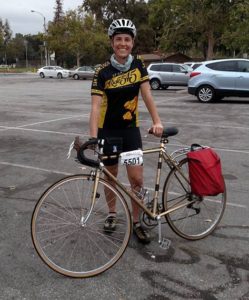
Much like my friends…who will need to donate generously if I’m ever going to raise that $20K.
January 16, 2017 Comments Off on Like Riding a Bike
Wham, bam, thank you, ma’am
Wham Bam Thank you Ma’am
A few weeks ago, I got in a car accident. I’m alright, but my car’s not. I mean really not. Pirus the Prius is dead. His organs will be divided up and parceled out to other cars, so I suppose he’ll live on. But it hurts.
And, honestly, I’m still waiting on test results to find out how “alright” I am.
For anyone who hasn’t gone through the circus show of being in a wreck, I’ll just say that it’s enough to make me consider not driving at all.
The guy who hit me pulled an illegal u-turn directly into the front of my car. No idea why, other than that he “didn’t see” me. At full speed. In the middle of Santa Monica Blvd.
Thank goodness it wasn’t my fault. It’s really good in terms of insurance etc. But really hard in terms of PTSD. Now, every time I feel the brakes, I get a pang in my gut, and my back and neck and shoulder. Everywhere that still hurts from being slammed into.
I don’t really want to relive the incident itself, but the process afterward is something else.
Immediately afterward, the 911 call was a trip. This all happened in Los Angeles, so it was the LAPD dispatch that responded to me as I sat in the smoke from the airbag that had discharged.
“Is anybody injured?” this was her insistent question.
“I don’t know.”
“Ma’am, is anybody injured?”
“I don’t know.” I’d just been hit going 35 mph. The only thing I knew was that I could talk and that I hurt.
“Can you ask?”
“No. Well, yes, it’s me. I don’t know if I’m hurt.” I could see the other driver walking around his car.
“Ma’am, I need to know if I should send an ambulance.”
“I don’t know.”
“Do you want me to send an ambulance?”
I ran a quick inventory of my body. Nothing seemed to be bleeding or sticking out strangely.
Ambulances are expensive. I don’t have health insurance. Fuckers. Went through my brain.
“No. Can you send police? We’re blocking the road.”
“Yes. Please stand by for police instruction.”
Then 911 put me on hold.
In the mililseconds after the crash, I considered what to do. I’d just left my girlfriend’s apartment after a lovely afternoon together. She was the first person I wanted to call. But my logic told me we should get 911 in process first. Now that I was on hold, however, I decided to text her and ask her to come my way. I’d need a ride. And I really wanted a hug. Mostly, I just wanted to see her face.
So I started texting. And accidentally hung up on the dispatcher.
I dialed again, and went through the same song and dance, this time with a different dispatcher.
“Is anyone hurt?”
“I don’t know. Can you just send police, please?”
“No.”
What? “I’m sorry, no?”
“We can only dispatch police if someone is receiving medical transport. Do you need an ambulance?”
I was shaken, and this guy was in no way helping. My sense of righteous indignation, however, was completely intact. “So what you’re telling me is that, because I don’t have health insurance, you’re not going to send LAPD?”
It wasn’t a fair question, but I was still inhaling fumes from the airbag, and just beginning to realize that I was seriously bruised form the seat belt. And I was pissed.
“No, ma’am, I’m just telling you our policy.”
“Well, you’ll want to send someone to direct traffic. We’re blocking both lanes of the street.” Surely, he’d see the reason in that.
“You’ll need to move your cars.”
“They’re not driveable.”
“You’ll need to call tow trucks.”
“Yes. Of course. But we can’t direct traffic.”
People were starting to gather around the vehicles.
“Does the other driver have a valid license and insurance?”
“I don’t know. I was hoping the police could determine that. I’m still in my vehicle.”
“Do you need an ambulance?”
“No.”
“Then I’m not sure what you want me to do.”
“Okay, fine. We’ll figure it out.” Click.
I was pretty much astounded. Gingerly, I opened the door and climbed out. I could walk. I could stand. I could tell I was beat up, but I was grateful that I was in one piece. My poor car, however, was a mess, crumpled and leaking everywhere.
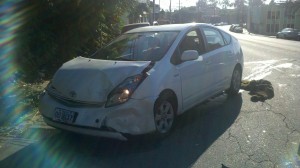
It appeared that the other guy had broken his front axle.
Witnesses began to approach and we started the process of exchanging information. I called my girlfriend and she started toward me in LA’s famous rush-hour traffic.
Then I sat back in my car and made another stab at getting LAPD on site.
“911 emergency.” It was the same guy. What were the chances? I mean really.
“There’s been an accident on Santa Monica Blvd. We need police to respond to the scene.”
Pause.
“Is anybody hurt.”
Violent sigh. “Okay, fine. At this point I’m going to say yes, please send an ambulance.”
When the paramedics arrived, we were all walking around. I was taking pictures, and the other driver was trying to pry his fender off his tire with a crow bar. I waved and the medics came over to me.
“Are you injured?” Was the first question.
“I was hoping you could tell me.” I was done with the song and dance. I was done. One of the guys was about as helpful as the 911 dispatcher. He just looked at me, waiting for my self-diagnosis. The other guy started an exam.
It was worth a try with these guys. “Really, we need LAPD out here, and I was told they couldn’t respond unless we have a medical transport.”
“Do you need to go to the hospital?” The unhelpful medic was looking at me again.
“I don’t know? Do I?” It was almost like we were all playing some big game with secret passwords that I didn’t know.
“You can come with us or you can drive yourself. You could probably wait until Monday and see if you’re still hurting then.”
“Great. I’ll do that.”
The helpful medic responded. “I’ll see if I can get LAPD out here.”
Finally. “Thank you.”
By the time LAPD had arrived, we’d exchanged info, taken pictures, and speculated about whether each car was a total loss. It took another half hour before we called tow trucks and got everything out of the street.
I know it’s LA, and there are more pressing things calling on the police, but seriously, I don’t think it’s the greatest idea to expect people who have just been in a pretty major accident to determine their injuries, evaluate each other’s documents for validity, direct traffic, and clean up the site of an accident.
When I told a friend about the experience, she said, “yeah, next time you’re in a wreck, just tell the 911 operator that you shot the SOB who hit you. It’s the only way to get LAPD to respond.”
Noted.
November 7, 2011 4 Comments
The hazards of banana farming
L.A. isn’t a place you dream of when you grow up in Idaho, and live in Oregon. It’s a place you curse.
But today, as my housemate and I harvested bananas from the backyard, laughing like little girls, I was happy to be in L.A.
There are some things you should know about harvesting bananas, however. First and foremost is that banana plants give off a sap that can be used as an adhesive. No really, it can be used as an adhesive. You don’t want that stuff on your skin, because it’s sticky. You don’t want it on your clothes, because it stains them hideously and immediately. And you really don’t want it in your eye.
Ask my housemate.
When I first moved in with Michele, she was out of town, in some far off land for a photo shoot.  While I was wandering the yard, marveling at the gorgeous fruit trees, I came across the wickedly serrated sickle she had pointed out to me that the gardener had left so that she could prune the banana trees that stood along the back fence. The trees had become so large and aggressive that they were constantly threatening to push over the fence. So I set to work. I cut out dead fronds and trimmed out weedy growth.
By the end, I had a pile four times the size of the yard debris bin. Eventually, I moved on to taking out entire, dying trees. Pulling down great monsters twenty feet high, by climbing on our little ladder with my sickle and taking them out in pieces.
The pruning did wonders, and we began to see fruit. The great, alien banana blossoms appeared like velvet, purple hearts beating at the end of green snakes. The trees grew heavy, bowing under the weight of the fruit.
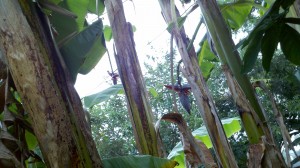
It’s an inspiring thing to be surrounded by food growing from the trees. As the summer has worn into fall, I’ve been ever more delighted. First the enormous fig tree in front began dropping its swollen bounty. Then the avocado tree took its turn, pummeling us with miniature fruit scarred with squirrel bites. One day I noticed a square-ish, green fruit on the ground and looked up to find the side yard dominated by a persimmon tree. Even our cactus gave me my first taste of prickly pear.
In the last few days, my quest for fruit has elevated. I pulled out the machete I’ve kept in my car for the last couple of years (for fire-making. I also keep a flint), and Michele and I went to work chopping up the trunk of a banana tree I’d cut out.
“Careful when you’re pulling the machete out,†I warned sagely. “There was a guy on Survivor who hit himself just above the eye doing the same thing. (The guy’s name was Alex. It’s actually happened a couple of times, but I digress.)”
I laughed about how Michele’s girlfriend would never let us play together again if one of us got hurt. Very soon, Michele had disappeared behind the back of the detached office to hack out some trees that she didn’t want growing there.
“Holy cow!†came her excited voice. “There’re even more back here!â€
“More what? Bananas?â€
“Yeah!â€
“Like fruit?!â€Â I’d been counting the blossoms proudly, noting their size and the size of the trees, and whether there were dead trees needing to come out nearby in order to give them access to more nutrients. The trees behind the office had escaped my count completely.
“Yes! Oh, damn, and it’s leaning on my fax line….I need the ladder.â€
I scrambled to hand the ladder through the tangle of trees to Michele, and climbed back to get a look at the bananas.
“WOW!â€Â There were a lot of them. And they were ready to harvest. We already had about 15 bananas ripening in a paper bag in the pantry from an earlier mission that had me atop a ladder, leaning over the fence with a pole saw, trying to retrieve the fallen bunch from the neighbor’s yard. But these bad boys behind the office were too good to pass up.
“I’ll climb up on the roof,†I offered. “Can it hold me?â€
“Yeah, no problem.â€Â We got the ladder into place, leaning steeply between the office and the fence. “You know what, I can get them,†offered Michele. “I want to get the leaves off my fax line, too.â€
Climbing up with the machete and sickle in her hands, she balanced one foot on the top of the fence and set to work. I held the ladder as best I could from the side and watched. She started with the fruit, cutting high up on the thick stalk. Immediately it started “bleeding.â€
“Oh yeah, just by the way, the sap totally stains,†she reminded me. More than that, the sap is incredibly sticky, and starts stinking pretty quickly.
She made it through and the heavy bunch dropped a foot. I grabbed at the blossom, hanging down toward me, and caught the three foot bunch when it swung down.
“Wow, it’s really pouring out!†I could hear Michele’s surprise as I moved around the corner to shove the bunch through the trees into the grass of the back yard. I took a second to marvel at the glorious harvest and then headed back to where she was murmuring.
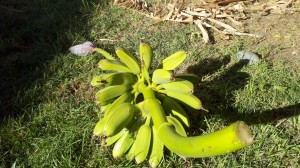
“It’s everywhere.â€Â She was squinting down at me. A large, green leaf was above her head, and sap was dripping like a rainstorm all around her. “I had my eye closed, but it dripped all over my face. Ahh! It’s all down my back! I’m coming down.â€
Michele made her way down, rubbing at her left eye.
“I think it’s in my eye,†she lamented when she hit the ground.
“Go wash it.†I said.
“It’s all over me.â€
“Shower time. Go.â€
I think the seriousness of the situation hit her all at once. She took off in a sprint for the back door, leaving her shoes in full stride on the deck.
“My eyelashes are stuck together.â€Â She was in the bathroom running water into her eye.
I wasn’t sure what to do. So I turned to the interwebs. (Of course.)
Banana sap in eye. Nothing.
Getting banana sap out of eye. Nothing.
I got banana sap in my eye.
Banana sap eye irritant.
Eventually I hit up on a couple of passing references, one to a guy who “almost lost his eye†when a bunch of banana sap exploded into his face, the other a parenthetical note that you “DO NOT†want to get banana sap in your eye.
After maybe 20 minutes of flushing her eye, Michele emerged.
“How is it?â€
“Um, it’s okay. Kind of fuzzy.â€
“Fuzzy?! The internet says you definitely don’t want to get it into your eye.”
She looked at me. “Are there many things that you’d want to get into your eye?”
“That’s totally fair. Should we maybe take you to the doctor?â€
“Nah, I’m just trying not to think about it. I’m going to get some pretzels and watch Mad Men.â€
Frankly, pretzels and Mad Men was as plausible a cure as anything I turned up on the internet.
While Michele applied her home remedy, I cleaned up the bananas, cutting the bunches from the stalk and washing the cobwebs from the fruit.
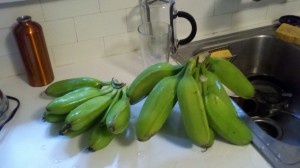
By the end of the night, we had another forty green bananas closed into paper bags to ripen in the pantry. Thankfully, Michele’s girlfriend was suitably impressed and didn’t ban us from playing together. It only took another 3 or 4 days for Michele’s fuzzy eye to return to normal.
Next time w play “banana farmers†I’ll lay off the warnings about machetes, and stick to the warnings about the real danger: banana sap.
October 31, 2011 2 Comments
A Perfect Landing
It’s been a while. Like, really a while. Yes, I’ve been traveling a bit. I’ve also been (gasp) settling a bit. I know. I know. More to come on that.
It all started with another movie-making adventure. I came down to California to work with some friends on a movie. One written and directed by Nicole Conn. If you don’t know who that is, you’re probably not a lesbian. At least not one of my generation. Because Nicole Conn also wrote and directed one of the only lesbian films that existed when I was in college, “Claire of the Moon.” She also directed last year’s “Elena Undone.”
Listen, when you’re in college and trying to find anything that looks like your life, a movie like the ones that Nicole makes are a lifeline.
So, when I had the opportunity to work on the new film, “A Perfect Ending,” I jumped. I don’t have much experience making movies at all. So, I was a Production Assistant – a “PA”. I emptied trash, and fed the crew, and ended up with some amazing new friends. A new film family that led me to where I am now, living just outside Hollywood, where I’m still working with Nicole’s production company to get this film finished.
That means, I’m working to get this film funded.
I don’t often ask you to do anything. I just ask you to read, and occasionally to comment. Once in a while I ask you to vote for me for something. Now, I’m asking you to support this project that I’m working on.
Because it’s important.
If you’re queer, it’s important to your community. If you’re not, it’s important to my community – a community I consider you a part of as an ally of mine. Either way, it’s important to me. So please read on.
It’s nearly election season again. That’s right. Soon, we’ll all be receiving calls and mailings telling us how important it is that we support causes and politicians that support our community.
But what about just supporting our community?
When’s the last time you had a conversation with a politician? How about the last time you watched a movie, or read a book about our community? Picked up a community newspaper?
The truth is that we rely on the artists that create gay content far more often than we rely on our politicians to support our community. So it’s time to give back.
There was a study that came out recently of how often certain segments of the population go to the movies. Lesbians were smack-dab at the bottom. Seems we go to see a movie in a theater less than once a year.
Yes, I know it’s expensive, and we’re all busy saving the world instead of making money, but here’s why this is significant: when film producers look at whether it makes sense to fund a movie, they look at what segments of the population will support the film in the theater. Which means that almost nobody will fund a lesbian film. Because we don’t go to movies.
And if our movies don’t get made, our stories don’t get told.
That leaves two ways we can work, as a community, to change this.
- Go to a movie. No really. Go to a movie once a month. Any movie. Think of it as a contribution to the arts. Arts in your community.
- Donate. Give money. Many of us donate generously to political causes, because we understand the importance of the political system in our lives. We know that when we support a politician, they can carry our story with them, and support the communities that are important to us.
We need to do the same thing with our artists. Whether it’s donating to a queer journal, or becoming a funder of a gay film, we need to recognize that this is the only way our stories will be told – if we finance their creation.
Right now, there is a film that needs our contributions. Writer/Director Nicole Conn has spent her lifetime telling our stories. Whether in the lesbian classic “Claire of the Moon,†or last year’s longest-kiss-in-screen-history, “Elena Undone,†Nicole and her production company, Soul Kiss Films are telling our stories. They are also working incredibly hard to fund those stories.
Will you step up and be part of a community that supports its artists? Will you be part of a community that values itself and its stories?
Go now. Donate. $5, $5,000, it all makes a difference. This is a project I have been working on, because I believe in the movie, I believe in the people who are telling our stories, and most importantly, I believe that our stories deserve to be told.
Go now. Go Here. Give what you can, and help tell your story. Our story.
And tell them I sent you. As soon as we finish funding the movie, I’ll be back to writing about my adventures. For now, we have a movie to make.
May 29, 2011 10 Comments
Findings at Machu Picchu
It was still misty when we entered the site of Machu Picchu. The only real indication that there might be something different, around us was the sudden absence of foliage, which had given way to orderly terraces.
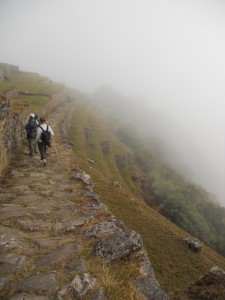
What we couldn’t see was the arching complex of building and walls, walkways and aqueducts. It wasn’t until we walked out to the edge of a giant rock pulled, out the binoculars, and peered down into the mist, that the familiar shapes, filed in our brains from the pages of textbooks and travel programs, began to emerge.
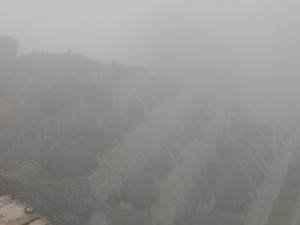
While the mist thinned under the rising sun, we explored the upper terraces.
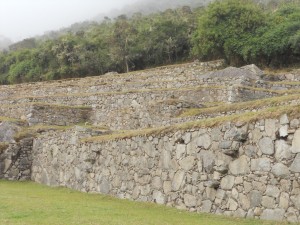
The irregular rocks were fitted expertly into each other, forming tall, solid terrace walls. The only rocks protruding from the sides were there by design – steps to climb from one level to the next. The grasses were short and thick, and scattered with piles of smooth black pellets, evidence of the llamas that inhabit the ancient site.
Before entering the lower site, we checked our packs, and looked for Kelly, our fellow-traveler who had stayed behind in Cuzco while LeAnna and I hiked the trail. We’d planned ahead of time to meet at the main gate. But we were late, and Kelly was nowhere to be seen. After about 20 minutes, we checked with Odon, who called the tour office to check for messages. Then we called the hotel. Nothing. I even tried to see if we could cross reference ticket numbers to determine if she’d already entered the site. No luck.
I loaded a small pack for the 6 hours we’d spend inside the site, making sure to pack my binoculars. They might be our only hope of finding that day Kelly.  Then we reentered Machu Picchu, the sun beginning to stream through the clouds.
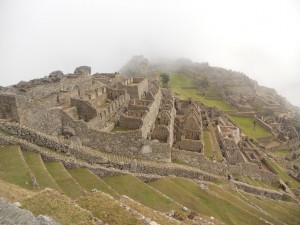
The site was massive. Odon served as our guide for the first two hours. He took us through the noble houses, where the stones were smoothed from the rough-hewn blocks that made up the majority of the buildings, and then into the sun temple, where the stones were polished even further, indicating the deeply sacred nature of the space.
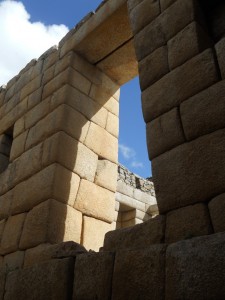
One theory about Machu Picchu is that it was the city of the Inka. Like, THE Inka. The dude in charge of the empire. That this place was where the most sacred priests lived, and where the family of the Inka lived. Nobody really knows, but there are a lot of temples there. There was the Sun Temple, climbing organically out of a large rock base in the middle of the site.
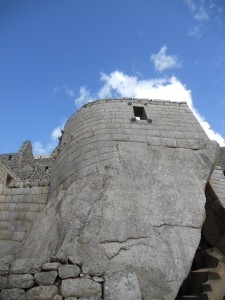
The temple of the Condor, where blood would be fed to the condor through the little hole at its beak that leads to an underground cavern (the stomach), which would hold the rest of the offering.
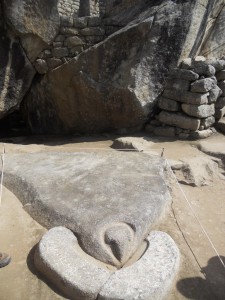
The main temple,
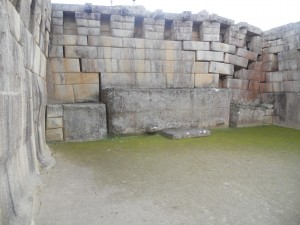
with it’s sacred sundial (which was damaged during the making of a car commercial – for real).
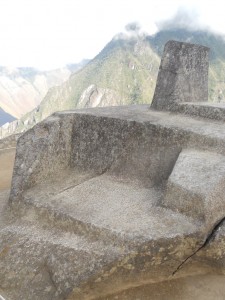
Machu Picchu is home to a number of other sacred rocks. Those that look like the actual sacred mountains that surround them.

The sacred rock is in the lower right hand corner, mirroring the shape of the mountain in the middle.
Rocks that, when lain upon transfer the energy of the earth.
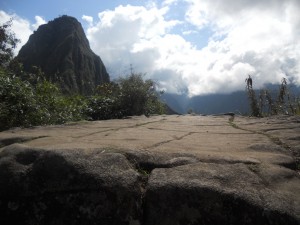
And those that, by their energetic makeup are believed to impart power to individuals who touch them.
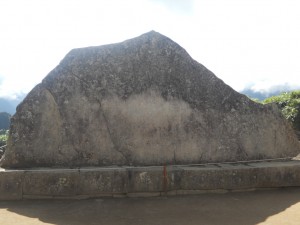
One such rock sits at the base of the trail to Huayna Picchu, the tall spire of a mountain at the back of the site.
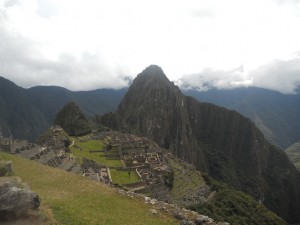
The stone, which shows visible sign of centuries of human hands touching its surface, is part of a resting area, a meditative retreat believed to help prepare travelers for the difficult hike to the top of the mountain, and the Temple of the Moon.
Odon warned us against touching the stone. “You have to have the right makeup – the right energy.â€Â He told us that the high quartz content of the stone could make you feel sick if you weren’t ready for it.
Nobody in our group saw the Temple of the Moon, not because we didn’t want to, but because the government has greatly restricted the number of people who can climb the trail each day. In order to get a ticket, you have to be at the Machu Picchu gates around 5:30am.
So we were relegated to the lower site, with its llamas and terraces.
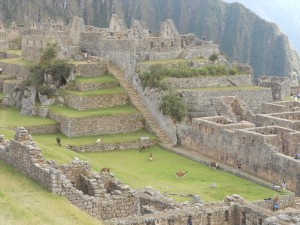
At one point, one of the llamas, who roam free throughout the site, stepped across the path, separating our group for a good 5 minutes, before it decided to move along.
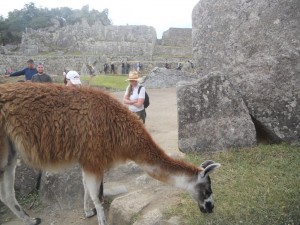
One of the women in the group called to those of us nearest to just move past it. The guy next to me looked over and said, “You go ahead. I raise llamas. I have no intention of getting kicked in the head.â€Â So we waited until we were allowed to move to our next stop.
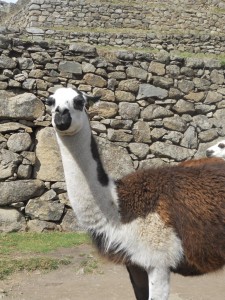
While we walked, we were constantly scanning the site for Kelly. She was there somewhere, in a straw cowboy hat, and a red backpack. I was quite certain we could find her, if we kept the binoculars handy, and kept a steady eye out for her. But the pure vastness of the place, with its sharp turns and steep angles made it difficult to see much.
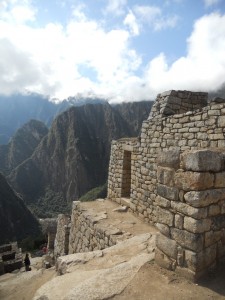
To make matters slightly more challenging, Odon informed us that, very soon, 10,000 new visitors would be arriving, making it virtually impossible to find anyone.
Just as we were winding down our visit, deciding that we’d be more likely to find Kelly in the tiny streets of Aguas Calientes, the town at the base of the mountain, I spotted her through my binoculars.
“No way. She’s there!â€Â Climbing the steps to the main temple, Kelly’s hat and backpack made her stick out. LeAnna and I ran through the site, (until we were stopped by guards) catching Kelly’s attention, ugly-American style, by jumping and waiving from below the temple.
“Where were you? Sorry we were late! We’ve been searching for you.â€
“Didn’t you get my note?â€Â Kelly looked at us a little baffled. “I left it for you at the bag check.â€
Of course she did. It was the thing that made the most sense. And the one thing we hadn’t checked. Brilliant.
As it turned out, Kelly, unable to make the three-day trek with us, had scored one of the coveted tickets to the top of Huayna Picchu and the Temple of the Moon.
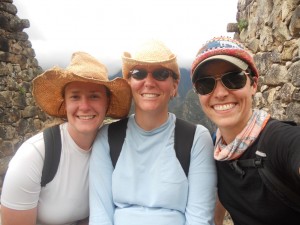
We compared notes on what parts of the site we had seen, and made a plan that would take us through the rest and get us on a bus to the town in time for a final meal with our group.
Our last, winding walk through Machu Picchu was hauntingly memorable. We found beautiful, framed views,
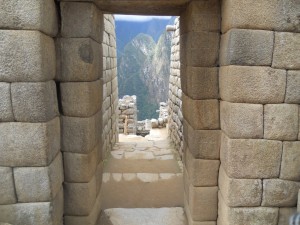
ancient rooms,
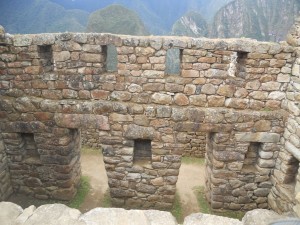
and amazingly preserved details.
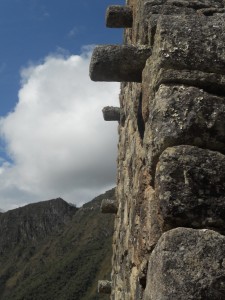
Even so, Machu Picchu, with its temples and stones, revealed nothing of its secrets to us. None of us became shamans. None of us had life-altering visions. But we did find each other. Amid the mysteries, in a spot of sunlight, we saw each other, before the mist returned to blanket Machu Picchu once more.
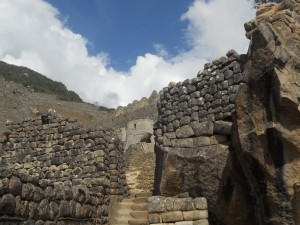
February 4, 2011 Comments Off on Findings at Machu Picchu


